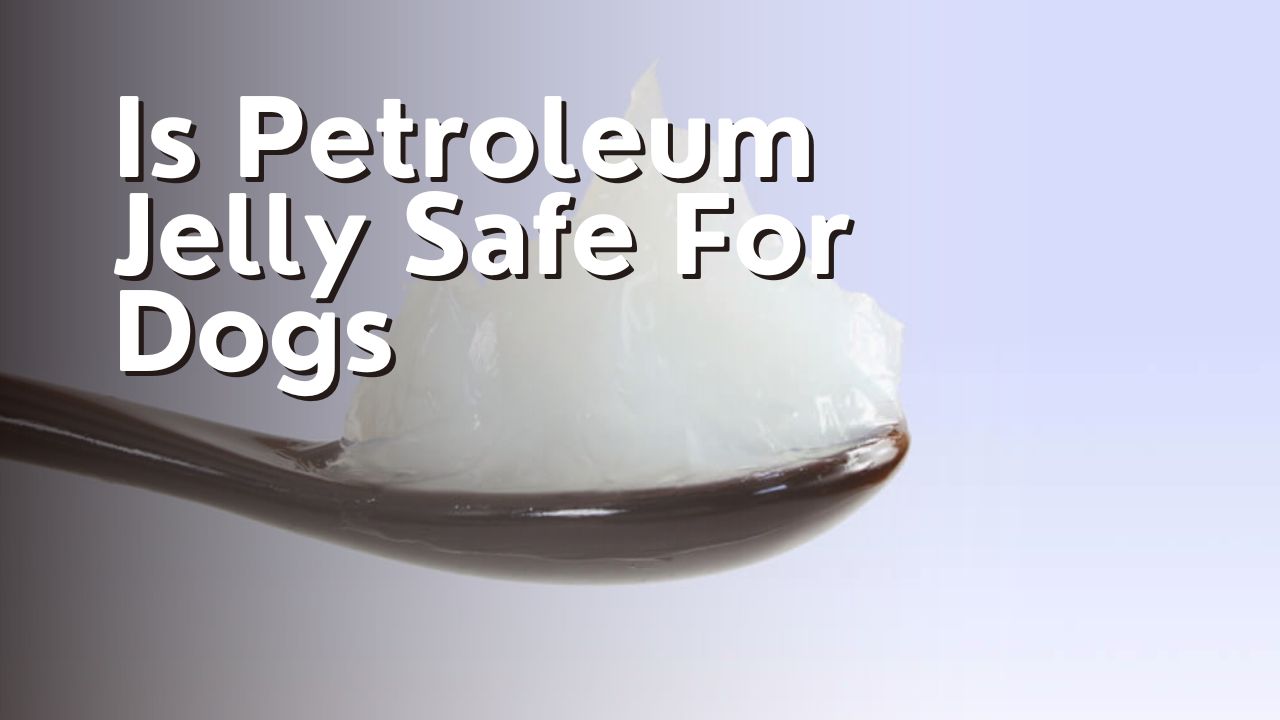Hey there! Have you ever wondered if petroleum jelly is safe for our furry friends? Well, I’ve done some research and I’m here to share what I’ve found.
As a dog owner myself, I understand the importance of keeping our pets happy and healthy. So, let’s dive in and explore whether or not petroleum jelly is a safe option for our canine companions.
Petroleum jelly, commonly known as Vaseline, is a widely used product with various applications. Many people use it for moisturizing and protecting their own skin, but what about using it on dogs? Is it safe?
We’ll delve into the composition of petroleum jelly, potential risks and side effects for dogs, as well as the benefits and proper usage guidelines. Additionally, we’ll explore alternative safe and natural remedies for any skin issues our furry friends may have.
So, join me as we uncover the truth about petroleum jelly and its safety for dogs.
Understanding the Composition of Petroleum Jelly
@ Midjourney AI Image Prompt: /imagine prompt:Create an image featuring a transparent jar filled with petroleum jelly, surrounded by magnified, colorful molecules. Show the intricate arrangement of hydrocarbons, waxes, and mineral oils to visually illustrate the complex composition of petroleum jelly. –v 5.2 –ar 16:9
Petroleum jelly, or ‘petrolatum,’ is a versatile substance that’s widely used for its moisturizing and protective properties. It is a semi-solid mixture derived from petroleum, which is a fossil fuel. The main components of petroleum jelly are hydrocarbons, specifically long-chain alkanes. These hydrocarbons are what give petroleum jelly its smooth and oily texture. They form a protective barrier on the skin, preventing moisture loss and providing relief for dry and chapped skin.
One important thing to note is that petroleum jelly is generally considered safe for dogs when used externally. It can be applied to their paw pads to protect them from harsh weather conditions or to soothe dry and cracked skin. However, it is crucial to avoid letting dogs ingest large amounts of petroleum jelly as it may cause gastrointestinal issues.
Another concern is the potential contamination of petroleum jelly with harmful substances such as polycyclic aromatic hydrocarbons (PAHs). PAHs are known to be carcinogenic and can pose health risks if ingested or absorbed through the skin. Therefore, it is essential to choose a high-quality petroleum jelly that has been purified and does not contain any harmful contaminants.
In conclusion, while petroleum jelly can be safe and beneficial for dogs when used externally, it is important to exercise caution and use it in moderation. Always consult with a veterinarian before using any new product on your furry friend to ensure their safety and well-being.

Potential Risks and Side Effects for Dogs
While using this popular product, it’s important to be aware of any potential risks or side effects that may affect your furry companion. Although petroleum jelly is generally safe for dogs, there are a few precautions to keep in mind.
- Ingestion: Dogs are curious creatures and may try to lick or ingest petroleum jelly if it’s applied to their skin. While a small amount is unlikely to cause harm, ingesting large quantities can lead to gastrointestinal upset, such as diarrhea or vomiting.
- Allergies: Just like humans, dogs can have allergic reactions to certain substances. While rare, it is possible for a dog to develop an allergy to petroleum jelly. Signs of an allergic reaction may include itching, redness, swelling, or hives. If you notice any of these symptoms, discontinue use and consult your veterinarian.
- Respiratory Issues: Petroleum jelly has a thick consistency and can be difficult for dogs to breathe if applied near the nose or mouth. It’s best to avoid applying it to these areas to prevent any potential breathing difficulties.
- Slippery Surfaces: When petroleum jelly is applied to a dog’s paws, it can make them slippery. This may be a concern if your dog walks on slippery surfaces or if you’re planning a rigorous activity for them.
- Toxic Ingredients: Some petroleum jelly products may contain additional ingredients, such as fragrances or additives, that can be toxic to dogs. Always check the label and avoid using products that contain harmful substances.
By being aware of these potential risks and taking necessary precautions, you can safely use petroleum jelly on your dog’s skin. However, if you have any concerns or notice any adverse reactions, it’s always best to consult with your veterinarian for guidance.
Benefits of Using Petroleum Jelly on Dogs
One of the advantages of using petroleum jelly on your furry friend’s skin is that it can help moisturize and soothe dry patches. This product forms a barrier on the skin that locks in moisture, preventing further drying and promoting healing. Additionally, petroleum jelly can provide relief from itching and irritation caused by dryness.
To illustrate the benefits of using petroleum jelly on dogs, here is a 2 column and 5 row table:
| Benefit | Explanation |
|---|---|
| Moisturizes | Helps hydrate the skin, preventing dryness and promoting healing. |
| Soothes | Provides relief from itching and irritation caused by dry patches. |
| Protects | Forms a barrier on the skin, preventing further drying and damage. |
| Non-toxic | Safe for dogs if used as directed, but avoid ingestion. |
| Versatile | Can be used on various areas of the body, such as paws, elbows, and nose. |
It’s important to note that while petroleum jelly is generally safe for dogs, it should not be ingested. If your dog licks or ingests a significant amount, it may cause digestive issues. Also, it’s always a good idea to consult with your veterinarian before using any new products on your pet’s skin.
Proper Application and Usage Guidelines
Using petroleum jelly on your furry friend requires proper application and adherence to usage guidelines for optimal results. Here are some important things to keep in mind when using petroleum jelly on your dog:
- Clean and dry the area: Before applying petroleum jelly, make sure to clean and dry the affected area on your dog’s skin. This will help ensure that the jelly is able to properly adhere and provide the desired benefits.
- Apply a thin layer: It’s important to apply a thin layer of petroleum jelly on your dog’s skin. This will prevent the jelly from becoming too greasy or causing any discomfort for your pet.
- Avoid sensitive areas: Be cautious when applying petroleum jelly around your dog’s eyes, nose, or mouth. These areas are sensitive and the jelly may cause irritation or discomfort.
- Monitor your dog: After applying petroleum jelly, keep an eye on your dog to ensure they don’t lick or ingest it. While petroleum jelly is generally safe if ingested in small amounts, excessive consumption may cause digestive issues.
By following these guidelines, you can safely and effectively use petroleum jelly on your dog. Remember to consult with your veterinarian if you have any concerns or if your dog’s condition worsens.
Alternative Safe and Natural Remedies for Canine Skin Issues
Looking for natural solutions to soothe your pup’s skin? Try these alternative remedies for canine skin issues! When it comes to caring for our furry friends, it’s important to consider safe and natural options. Here are some effective alternatives to petroleum jelly that can help alleviate your dog’s skin problems.
| Remedy | Benefits |
|---|---|
| Coconut oil | Moisturizes and soothes dry skin, while also providing antibacterial and antifungal properties. |
| Aloe vera | Has cooling and healing properties that can relieve itching and inflammation. |
| Chamomile tea | Can be used as a topical rinse to soothe irritated skin and promote healing. |
| Oatmeal | Helps to calm itching and reduce inflammation, making it ideal for dogs with allergies or sensitive skin. |
These natural remedies offer a gentle and non-toxic approach to managing your dog’s skin issues. However, it’s important to remember that every dog is unique, and what works for one may not work for another. If your dog’s skin problems persist or worsen, it’s best to consult with your veterinarian for a proper diagnosis and treatment plan. Remember to always prioritize your pup’s health and well-being by using safe and natural alternatives whenever possible.

Frequently Asked Questions
Can petroleum jelly be used on all types of skin issues in dogs?
Petroleum jelly can be used on various skin issues in dogs, such as dryness or minor cuts. However, it’s important to consult a veterinarian before using it, as some dogs may have adverse reactions or require alternative treatments.
Can petroleum jelly be harmful if ingested by dogs?
Petroleum jelly can be harmful if ingested by dogs. It may cause gastrointestinal upset, such as vomiting or diarrhea. It’s best to avoid letting dogs consume petroleum jelly to prevent any potential health issues.
Can petroleum jelly be used on puppies?
Petroleum jelly can be used on puppies, but it’s important to be cautious. While it can help with dry skin or minor irritations, it should not be ingested and should only be used externally.
Can petroleum jelly be used on dogs with sensitive skin?
Yes, petroleum jelly can be used on dogs with sensitive skin. It helps soothe dryness and protects against irritation. However, it’s always best to consult with a veterinarian before using any products on your dog’s skin.
Can petroleum jelly be used on dogs with open wounds or cuts?
Yes, petroleum jelly can be used on dogs with open wounds or cuts. It helps create a protective barrier, keeping dirt and bacteria out while promoting healing. However, it’s important to consult a veterinarian for proper guidance.
Conclusion
In conclusion, I’ve found that petroleum jelly can be safe and beneficial for treating certain skin issues in dogs. However, it’s important to be aware of the potential risks and side effects. It’s also crucial to follow proper application and usage guidelines. Consulting with a veterinarian before using any products on your furry friend is always a good idea. Additionally, there are alternative safe and natural remedies available that can be effective in treating canine skin issues.


